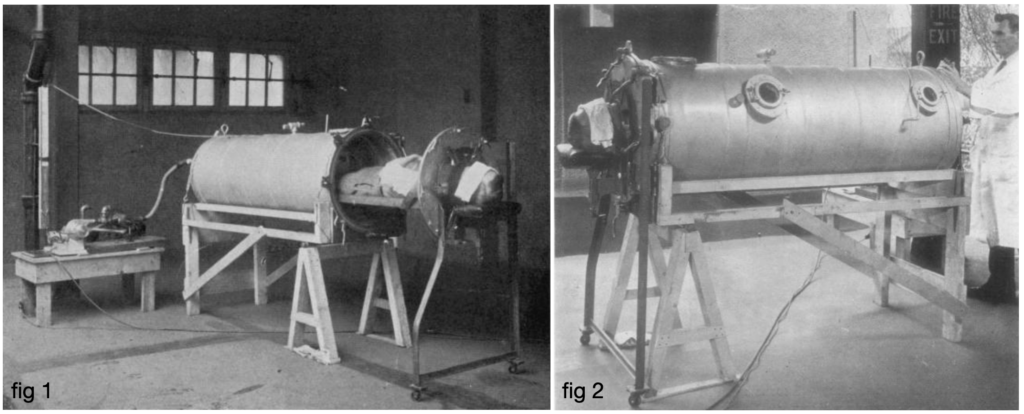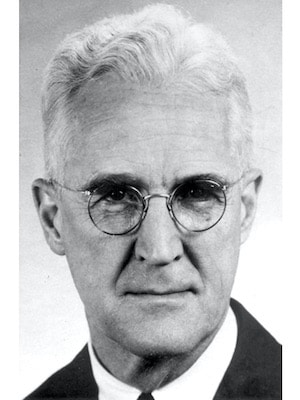Philip Drinker
Philip Drinker (1894 – 1972) was an an American Industrial Hygienist and chemical engineer
Innovator behind the Drinker Respirator or Iron Lung which found wide-spread use during the Polio epidemic where it has saved thousands of lives.
Drinker developed his concept of negative pressure artificial ventilation using a Luer syringe to force air in and out of the box containing a paralysed cat. Drinker realised the potential for his invention came after witnessing polio victims at a Children’s Hospital in Boston.
His work as an Industrial Hygienist saw Drinker become a pioneer within the field where he is considered the ‘father’ of industrial hygiene. An achievement that is all too often overshadowed by that ‘damned machine’ as Drinker called it
Biography
- Born on December 12, 1894 in Haverford, Pennsylvania
- 1915 – graduates Bachelor of Science (S.B.) from Princeton
- 1917 – graduates Chemical Engineering (Ch. E) from Lehigh University
- 1921 – assistant professor in Ventilation and Illumination at Harvard University; spends much of his time studying industrial dusts and fumes, industrial hygiene and toxicology.
- Collaborates with colleague Louis Agassiz Shaw Jr (1886-1940) in developing the respirator initially in response to gas poisoning; presents his invention (modelled on anaesthetised cats) to the Consolidated Gas Company of New York and is awarded a US500 grant to develop the apparatus for human use.
- After being called to a Children’s Hospital to design a climate-controlled room for premature babies, Drinker witnesses children dying from asphyxiation from Polio. Becomes motivated to adapt a respirator for human use, using himself and colleagues as test subjects for his prototype respirator
- 1928 – the respirator is used for the first time on a patient suffering from infantile paralysis in the Children’s Hospital in Boston. The child is successfully artificially ventilated for 122hours however subsequently dies from cardiac failure
We recently had an opportunity to apply our respirator in a case of intercostal paralysis from poliomyelitis. The patient, a child of eight years, was in the machine almost continuously for a period of 122 hours…death occurred….apparently from cardiac failure brought on by an extensive bronchopneumonia…Examination of the lungs at autopsy showed no evidence of trauma from overinflation, nor was any other form of damage to the patient from this prolonged application of artificial respiration observed. During the time the child was in the respirator, she was able to talk, sleep, and take nourishment while the pumps were running
J Clin Invest. 1929
- 1931 – Polio epidemic sees increasing demand for the respirator and soon every hospital in the nation is equipped with one; receives the Annual John Scott Medal from the Franklin Institute for his invention ‘most conducive to the comfort, welfare and happiness of mankind’
- 1936 – publishes a seminal book titled Industrial Dust; is one of the first to recognise the impact of industrial air contaminants on health and devises methods of protection against lung diseases such as silicosis
- 1939 – founded then American Industrial Hygiene Association (AIHA); 4th president in 1942; editor in chief of The Journal of Industrial Hygiene
- 1942 – president of the AIHA
- Died on October 19, 1972
Medical Eponyms
The Drinker Respirator
Our respirator in its present form…is a rather cumbersome and complicated apparatus – it is a clinical tool to be used in hospitals under the direction of competent clinicians
Drinker 1929

fig. 2. Patient in the respirator Drinker 1929
The Drinker Respirator consisted of a large metal cylindrical tank with a rubber collar fitted to provide a seal around the patient’s neck as well as maintain a pressurised environment within the chamber. An electrically driven air pump is connected to a valve mechanism which allows for alternating negative and positive pressures to be induced. Air is sucked out to produce a vacuum or negative pressure causing the chest and abdomen to expand for inspiration and pushed in for exhalation as the positive pressure causes the chest and abdomen to partially collapse. Pressure could be applied up to 60cm of water and at a rate of 10-40 breaths/minute.
The pressures are recorded by a water manometer connected to the respirator. A second manometer attached at an angle is used to detect respiratory movements when the pump is switched off. A separate ‘hood’ can be attached to enclose the patients’ head to deliver oxygen supplied from a compression cylinder.
Variations of the Drinker Respirator emerged over the years, the most notable include:
- 1931 Emerson Respirator: developed bv John Haven Emerson (1906-1997), an American businessman; the Emerson respirator incorporated a sliding bed and portholes in the tank to allow for access to the patient
- 1934 Henderson respirator: the first iron lung in Britain; developed by Robert Henderson
- 1937 Both respirator: developed by brothers Edward and Don Both in Australia based on the Drinker Respirator. The cabinet was constructed from Plywood which made this respirator a cheaper and lighter alternative to the Drinker respirator
With the advent of the Polio vaccine, endotracheal intubation and positive pressure ventilation, the Drinker Respirator is now largely obsolete although its private use particularly in Polio survivors, see it persist almost a century after its introduction.
Major Publications
- Drinker P, Shaw LA. An apparatus for the prolonged administration of artificial respiration: I. A Design for Adults and Children. J Clin Invest. 1929 Jun;7(2):229-47.
- Shaw LA, Drinker P. An apparatus for the prolonged administration of artificial respiration: II. A Design for Small Children and Infants with an Appliance for the Administration of Oxygen and Carbon Dioxide. J Clin Invest. 1929 Dec;8(1):33-46
- Drinker P, McKhann CF. The Use of a New Apparatus for the Prolonged Administration of Artificial Respiration I. A Fatal Case of Poliomyelitis. JAMA. 1929; 92(20):1658-1660
- Drinker P, Shaw LA. The prolonged administration of artificial respiration. Journal of the Franklin Institute. 1932; 213(4): 355–72
- Drinker P, Hatch T. Industrial Dust: Hygienic Significance, Measurement and Control. 1936
Controversies
Despite the huge success of the Drinker Respirator, it was incredibly costly more than $2000 apiece to make and could not be made fast enough to meet the growing demand brought by the Polio epidemic. As such, it was inevitable that others would attempt to improve upon the original design.
In this respect and foremost was the inventor and businessman John Haven Emerson who introduced an improved and cheaper model of the Drinker Respirator, renamed after its inventor ‘the Emerson respirator.’
Harvard and Drinker attempted to sue Emerson for patent infringement however were unsuccessful after Emerson was able to prove that components of the respirator had already been used or published by others previously. Drinker’s patents were subsequently voided.
References
Biography
- Fitzwilliam NH. Prof. Philip Drinker Dies at 77; A Co‐Inventor of the Iron Lung. New York Times Oct. 21, 1972
- Sherwood RJ. Philip Drinker 1894–1972, The Annals of Occupational Hygiene, 1973; 16(1): 93–94
- Akkermans R. Philip Drinker. Lancet Respir Med. 2014 Jul; 2(7): 525-6
- Bibliography. Drinker, Philip 1894-1972. WorldCat Identities
Eponymous terms
- Drinker-type iron lung respirator, London, England, 1930-1939. Science Museum Group
- Meyer JA. A practical mechanical respirator, 1929: the “iron lung”. Ann Thorac Surg. 1990 Sep; 50(3): 490-3
- Dhawan N. Philip Drinker versus John Haven Emerson: Battle of the iron lung machines, 1928-1940. J Med Biogr. 2020 Aug; 28(3): 162-168.
[cite]
Emergency registrar at Sir Charles Gairdner Hospital, Perth


